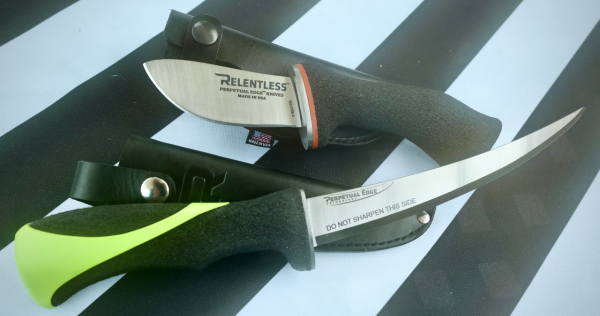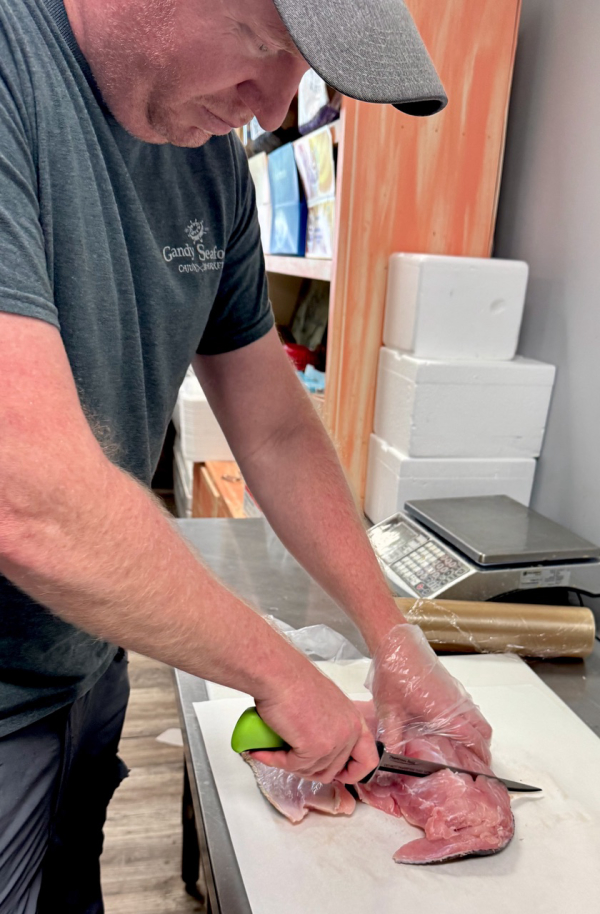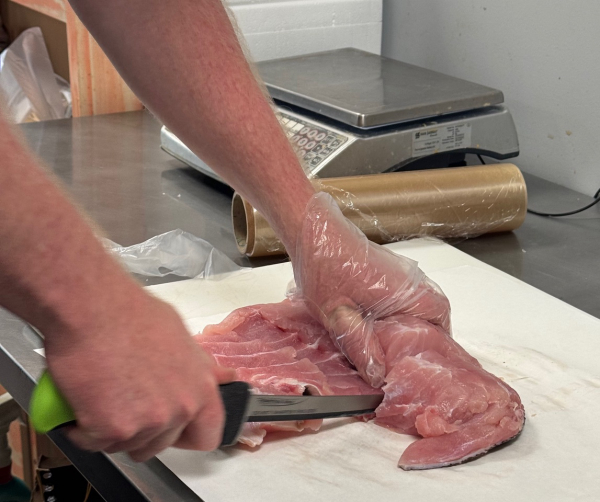Recently an industry acquaintance reached out to see if I’d be interested in trying out a new knife. Since I can no more resist a new knife than a 9-year old boy can ignore an abandoned puppy on his doorstep, I told him to “send it.”
It arrived, just before a long road trip. Normally, it would have gone to the space in my credenza where “I need to test this” stuff goes when I don’t have time to do anything with it.
Fortunately, I had an ultimately qualified contact who’d be perfect to try this “revolutionary” new knife. Oh, “it” is a Relentless perpetual edge fillet knife, “purpose built and designed to keep cutting.” That “keep cutting” the result of an aerospace grade titanium body combined with a hard carbide and crushed diamond “power strip” that not only created a perpetual edge, but sharpened as it cut.
That seemed a bit superheated, rhetoric-wise, but having broken my share of unbreakable gear, I wanted to find out how “perpetual” this purportedly perpetual blade really was.

To properly test a filleting knife, you have to either fish, or know someone who handles a lot of fish on a regular basis. Enter my friend Ben Meredith, owner/operator of the local Gandy Seafood Cajun Market. Being a frequent customer, I presumed he wouldn’t mind my imposing on him to guinea pig a new tool. His market breaks down a lot of fresh fish every week, along with the occasional alligator (it is a Cajun market), so I figured he would be the perfect tester.
So, on my way out of town I ran in the door, dropped off the knife and an orientation sheet and promptly forgot about both the knife, and the test.
Which is a good point to explain the Relentless concept as it was explained to me. Knife makers have always been faced with a conundrum: to prevent edge dulling, they use use harder blade steel. It improves wear, but mades for brittle edges that are also more difficult to sharpen. Rather than try a variation on the conventional, Relentless concentrated on creating a blade that would stay sharp.
They begin with a 100% aerospace grade titanium blade. It’s not just strong, it’s extremely lightweight, helping with wrist fatigue when filleting. But titanium has a super power in a fishing context: titanium is corrosion proof. Important for any angler, but really beneficial for a saltwater angler.
But wait, there’s more (always wanted to write that)…the cutting edge is micro coated with a carbide and diamond, forming tiny, jagged saw-like protrusions. They give the knife the ability to maintain a keen edge. They coated it with an anti-friction boron nitride compound to enhanced lubricity of the cutting edge and reduce friction.
The opposite end of the knife got my attention, the True Grit” handle. A glass reinforced ABS plastic covered with the same non-slip, non-abrasive stuff used to prevent slips around a swimming pool It’s supposed to help with holding the knife when hands are wet or slimy-or both.
Now back to our story….having forgotten I’d dropped the knife at Gandy, I was surprised when I was greeted as “the knife guy” when I dropped in for some fresh Gulf shrimp. I realized that the knife had made an impression, but the question was simple: good or bad?


“It took a little getting accustomed to,” Meredith told me, “but it cuts. I broke down a couple of good-sized fish the first time I used it. The first thing I noticed was how much I liked the grippy handle.”
“But it wasn’t until about three days and a bunch of fish later,” he said, “I realized it hadn’t dulled at all. That’s not normal. I’m used to having to sharpen my knives about every second big saltwater fish. I haven’t sharpened this one yet.”
“So,” I asked, “is that good or bad?” His response was the same eye roll I’d get asking a teenager a “lame” question.
“Contextual clue,” he said, “you can’t have it back.”
Meredith’s unwillingness to return the knife was fine, because I wanted to know what someone who used knives thought. He’s both an angler and a fishmonger, so I’d say that’s a double positive.
Currently, Relentless offers fillet knives in 6, 7, 8, 9 and 10 inch lengths from $149.99 to $169.99 and both inshore and offshore sets for $294.99. They also offer 3.6-inch hunting models in either drop-tip or hunter-skinner configurations ($149.99).
Finally, I am no professional at sharpening knives. Having “fixed” what I’ve “sharpened” the pros at Buck Knives can vouch for that inability. But I believe even I could sharpen these knives.
The recommended process for sharpening doesn’t call for a $1,000 Russian-made sharpening machine, six grades of Arkansas sharpening stones, or even a whetstone. The recommended material is “any sandpaper 400 grit or higher” placed on a mouse pad or other soft object. Hold the knife at a 20 degree angle with the said that says “DO NOT SHARPEN THIS SIDE” facing up, apply gentle pressure, and drag the knife across the sandpaper, adjusting to keep the blade (if curved) perpendicular to the sandpaper. Repeat 2 or 3 times, and you’re done.
Their hunting model is going with me this fall, and as always, I’ll keep you posted.
— Jim Shepherd